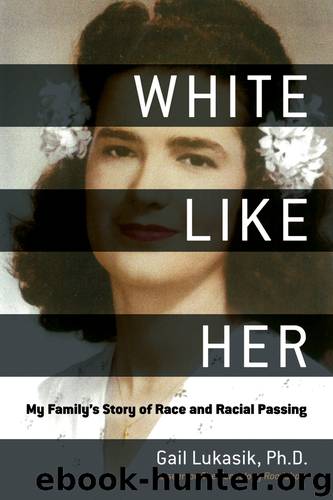White Like Her by Gail Lukasik

Author:Gail Lukasik
Language: eng
Format: epub
ISBN: eBook ISBN: 9781510724150
Publisher: Skyhorse Publishing
Published: 2017-04-04T04:00:00+00:00
By 1829 Ursin is living with Roxelane Arnoux, a free woman of color, in the suburb of Marigny, on Greatmen Street (now Dauphin Street) between Frenchman and Champs Elysees Streets where their first child, John Frederick, is born in 1829. On his birth record, John is described as the “child of their cohabitance” and his race is designated as colored. On the same document, Ursin’s age is given as thirty-nine years old and Roxelane’s age as twenty-five years old. Their fourteen-year age gap lends credence to this being a plaçage arrangement.
As to what happened to Marie Polline is only conjecture. Perhaps she died or Ursin became tired of her. Regardless, Ursin moved on to another woman. As to Ursin’s daughter by Marie Polline, in 1851 Marie Armande has a son Joseph and she is residing on St. Phillip Street near Rampart, the same street on which Ursin had his cabinetmaking shop in 1822. It’s unclear if it’s the same building that housed his carpentry business.
In subsequent birth records dated August 1835 and March 1837, Ursin and Roxelane’s children are described as “natural” or “from the cohabitation of” Roxelane and Ursin. The children of these plaçage unions were known as “natural” children as opposed to “bastard” children, an important distinction in many ways, but especially in terms of inheritance. Bastard children couldn’t inherit from their fathers, but natural children could inherit.
Like many plaçage liaisons, Ursin lived with Roxelane monogamously, dispelling the notion of the tragic quadroon, and his “natural” children were his heirs.5
For the majority of their lives together, Ursin and Roxelane resided in the Marigny area. In the early nineteenth century when Ursin and Arnoux established their residence, “New” Marigny, the area away from the river near Claude Street, was where the white Creole gentlemen set up their plaçage households.6 During that time, Marigny was composed of single and double Creole cottages. Many of the inhabitants were tradesmen, in occupations such as shoemaker, carpenter, blacksmith, butcher, and tailor. As a cabinetmaker Ursin’s trade was typical of the population.
By 1811 there were over 150 households living there. In 1830 when the city was divided into three municipalities, Marigny was included in the Third Municipality and all business was conducted in French. Reunification took place in 1851 and the Third Municipality became the Third District. By the 1840s with the influx of German immigrants, shotgun cottages were built with more frequency and became the dominant nineteenth-century New Orleans—type house.7
Though the houses may have looked charming, living in Marigny during the early nineteenth century was anything but charming. Because the ground water in the city had high mineral content making it unusable for drinking and washing, water had to be brought in by cask and cart. An open gutter served as the sewage system, and at night soil wagons collected human waste from the gutters, which was deposited into the river creating an awful stench.8
Another group of immigrants to the Marigny area in its early days were refugees from Santo Domingo. Roxelane Arnoux and her family might well have been one of those refugees.
Download
This site does not store any files on its server. We only index and link to content provided by other sites. Please contact the content providers to delete copyright contents if any and email us, we'll remove relevant links or contents immediately.
| Anthropology | Archaeology |
| Philosophy | Politics & Government |
| Social Sciences | Sociology |
| Women's Studies |
Cecilia; Or, Memoirs of an Heiress — Volume 1 by Fanny Burney(32080)
Cecilia; Or, Memoirs of an Heiress — Volume 3 by Fanny Burney(31471)
Cecilia; Or, Memoirs of an Heiress — Volume 2 by Fanny Burney(31425)
The Great Music City by Andrea Baker(30801)
We're Going to Need More Wine by Gabrielle Union(18648)
All the Missing Girls by Megan Miranda(14805)
Pimp by Iceberg Slim(13808)
Bombshells: Glamour Girls of a Lifetime by Sullivan Steve(13706)
Fifty Shades Freed by E L James(12930)
Talking to Strangers by Malcolm Gladwell(12898)
Norse Mythology by Gaiman Neil(12866)
For the Love of Europe by Rick Steves(11584)
Crazy Rich Asians by Kevin Kwan(8903)
Mindhunter: Inside the FBI's Elite Serial Crime Unit by John E. Douglas & Mark Olshaker(8727)
The Lost Art of Listening by Michael P. Nichols(7173)
Enlightenment Now: The Case for Reason, Science, Humanism, and Progress by Steven Pinker(6884)
The Four Agreements by Don Miguel Ruiz(6330)
Bad Blood by John Carreyrou(6286)
Weapons of Math Destruction by Cathy O'Neil(5855)
